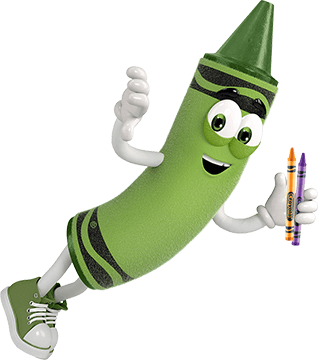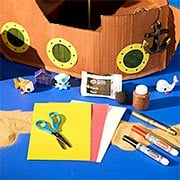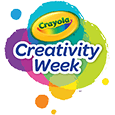Es posible que los marcadores de Crayola se hayan secado si se dejan sin tapa. A continuación se presentan algunas sugerencias para ayudar a revivirlos.
- Rotuladores de garabatos que cambian de color:
- Vuelva a colocar la tapa durante 72 horas (aproximadamente 3 días) antes de intentar usarla nuevamente.
- Marcadores de maravilla de color:
- No es a base de agua y no se puede revivir.
- Intente limpiar la punta, tape el marcador y guárdelo con la punta hacia abajo durante la noche si se deja sin tapar brevemente.
- Rotuladores Doodle de punta fina y punta ultrafina:
- No se pueden revivir ya que son tintas de rotulador permanentes.
- Marcadores de gel:
- Frote el marcador de un lado a otro sobre la superficie de dibujo.
- Si aún está seco, vuelva a colocar la tapa durante 2-3 horas.
- Alternativamente, sumerja la punta en agua tibia durante unos 5 segundos, vuelva a tapar y espere 24 horas antes de volver a intentarlo.
- Marcadores no basados en agua:
- Estos marcadores son permanentes y no se pueden revivir.
- ¡Toma nota! Bolígrafos de gel:
- Golpee la punta contra el papel para enganchar y desenganchar la punta hasta que vuelva a escribir.
- Si no tiene éxito, es posible que el bolígrafo esté vacío incluso si parece que queda algo de tinta.
- Rotuladores a base de agua (rotuladores regulares, lavables, ultralimpios, garabatos de doble punta, lavables antigoteo y de proyecto):
- Sumerge la punta en agua tibia durante unos 5 segundos.
- Vuelva a tapar el marcador y espere 24 horas antes de volver a usarlo.
¿Dónde puedo encontrar más información sobre los productos Crayola Marker y los consejos de almacenamiento adecuados?
- Más información sobre los productos Crayola Marker.
- Echa un vistazo a nuestras preguntas frecuentes para obtener los mejores consejos sobre cómo guardar tus rotuladores Crayola.
¿Necesita más ayuda?
- ¡Estamos aquí para ti! Llámenos o envíenos un mensaje de texto al 1-800-272-9652 de lunes a viernes entre las 9 a. m. y las 4 p. m., hora del este. Es posible que se apliquen cargos por mensajes de texto. Si lo prefieres, visita nuestra Página de soporte para enviarnos un correo electrónico.
Si tienes preguntas adicionales, ¡nos encantaría saber de ti! No dudes en llamarnos o enviarnos un mensaje de texto al 1-800-CRAYOLA días laborables entre las 9 AM y las 4 PM hora del Este. Si prefieres enviarnos un correo electrónico, visita nuestra página de contacto.
Preguntas relacionadas
Explora respuestas a preguntas comunes, consejos útiles para eliminar manchas e ideas creativas para aprovechar al máximo nuestros materiales de arte y recursos gratuitos.
-
Crayola® Markers are made with six components consisting of: a color solution, a porous plastic nib, a plastic barrel, a cotton filament (ink reservoir), an end plug, and a cap. Although specific ingredient information is proprietary, most of the color solutions in Crayola Markers are made from water and dyes. Below is the process we follow to make Crayola Markers.
- Tiny beads of plastic are fed into a molding machine where they are melted and then molded into marker barrels. The liquid plastic becomes solid, white marker barrels in a matter of seconds.
- Any extra plastic from the molding process goes back into the molding machine to make new marker barrels.
- The marker barrels are screen printed with the Crayola brand name and most with the color name of the marker. The process is like screen printing t-shirts, where the ink colors pass through a pre-made screen onto the printing surface. Up to 6 distinct colors can be used to decorate the marker barrel at one time! The ink dries quickly as the marker barrel passes through a drying tunnel.
- The assembly machine lines up the marker barrels in the same direction as they move along a conveyor belt. The end plug and ink reservoir are inserted into the marker barrel, and the color solution is injected into the soft reservoir. The marker nib, or drawing tip, is added to the open end of the marker, followed by the cap. It takes a minute or two for the ink to travel up from the reservoir to color the nib, so the marker is ready to write!
- The finished markers are placed in a sorter - a machine with separate sections for the assorted colors. A chute drops one marker of each color onto a conveyor belt, creating the colorful assortment that will fill the marker box.
- A robotic arm opens the flat marker boxes and sends them down the conveyor belt. Another robotic arm pushes the markers into the boxes and closes them. After the assembled markers are packed in large cartons, they are ready to be shipped to stores.
Did you know....
Crayola makes more than 700 million markers a year!
- The first box of Crayola Markers was introduced in 1978 and included 8 bright colors.
- In 2014, Crayola introduced Ultra-Clean Washable Markers. They clean up easily from skin, clothing, and painted walls.
- Crayola Broad Line Markers are tested to write a minimum of 300 feet - almost the length of a football field!
- Crayola Fine Line and Super Tips Markers are tested to write a minimum of 600 feet.
Learn more about Crayola Markers on the Crayola Markers Page.
-
Because Crayola® Marker components are securely sealed during the manufacturing process, we don't recommend trying to remove the marker nib and reservoir to recycle the barrel. The marker caps can be recycled at facilities that accept #5 plastic.
Green is more than just a color to us! Learn more about Crayola's sustainability initiatives.
-
The basic ingredients in Crayola® Markers are water and dye. A common experiment is to use paper chromatography to separate the dyes. When performing this experiment, you will find that not all Crayola Marker colors separate into different colors due to the nature of dyes utilized in creating marker colors. (Brown, violet and green markers work best). For example, only one dye is used to make our red color marker, but a number of dyes are used to make our brown color marker. In a chromatography experiment, the brown will separate into different colors; however, the red will not.
-
Introduced in 1998, Crayola® offers a variety of colored pencil assortments that are the essential creative tool for kids or the art enthusiast. Crayola colored pencils are manufactured in Brazil, Costa Rica or Vietnam due to their high-volume manufacturing capabilities.
The process of making Crayola Colored Pencils begins in the forest. Seedlings, which are young trees, are planted in fields much like a farmer plants a crop. Seedling crops grow into trees which are eventually used to make wood casings for the pencils. After several years, the trees are harvested, cut into even lengths, stacked onto trucks and shipped to the sawmill. Then, a new crop of seedlings is planted to replace those which have been harvested.
At the sawmill, lumber arriving by the truckload is stacked in large piles and allowed to dry. Once dry, the lumber is fed into a bark stripping machine which removes all the bark from each piece of lumber. Next, the lumber goes through a series of milling machines which cuts the lumber into rectangular slats. These slats are about as long as a colored pencil and about three inches wide. The slats are the building blocks for the production of colored pencils.
The slats are then transported to the pencil making plant. Here they are fed into another milling machine which cuts small semicircular grooves at regular intervals down the length of each slat. These grooved slats are now ready to accept a colored pencil core.
To make a Crayola Colored Pencil core, you need four raw materials:
- Extenders - which make up the body of the lead.
- Binders - to hold the ingredients together.
- Pigment - which gives each type of colored pencil its unique color.
- Water – to mix all the ingredients.
First, the extenders, binders, pigments and water are placed in a large mixer which gently kneads them together into a uniform doughy substance. When the mixing is complete, the contents of the mixer are rolled into flat sheets. Finally, these sheets are machine-pressed into large, long solid cylinder shapes. These shapes are called cartridges.
Each cartridge, while still damp and pliable, is inserted into another machine called an extrusion press, where it is forced through a small tube. The tube has a diameter equal to that of a colored pencil core. As the long rope of wet colored core comes out, an automatic slicer cuts it into equal lengths approximately as long as a colored pencil. Since the leads are still quite moist, they must be dried in large ovens before they become hard enough to insert into the slats.
To assemble the pencils, half of the grooved slats are fed into a machine which carefully lays a colored pencil core into each groove. Then a layer of glue is applied, and a second grooved slat is placed on top of the slat holding the lead. Think of this as a pencil sandwich, with each slat acting like a piece of bread and the color cores acting like the filling.
These pencil sandwiches are then bound very tightly together and placed into storage to give the glue time to dry. Once the glue is dry, they are fed into another milling machine which cuts them into individual colored pencils. Depending on the design of colored pencils, they are cut into either round or hexagonal shapes.
Next, the pencils are fed into a machine to be painted with the same color paint as the colored core. The pencils run down a conveyor belt to allow the paint to dry. The painted pencils are then sent to a machine to be automatically sharpened.
Finally, brightly colored finished pencils are packed into boxes, which are shipped to neighborhood stores.
Crayola Colored Pencils are used by people of all ages for everything from crafts to professional artwork and school projects. Learn more about Crayola Colored Pencils products.
-
It is difficult to provide an exact shelf life for Crayola products because it depends on how and where they have been stored. Our products are generally tested on the basis of how they are used, rather than how long they have remained unused. We stand behind the Crayola brand name and will work to take care of any quality issue you may encounter.




